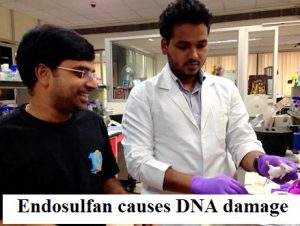For the first time, Indian researchers have found that mice and rats exposed to endosulfan suffer from DNA damage and genomic instability and impaired DNA damage response.
What is Endosufan ?
Endosulfan is an off-patent organochlorine insecticide and acaricide that is being phased out globally.
- The two isomers, endo and exo, are known popularly as I and II. Endosulfan sulfate is a product of oxidation containing one extra O atom attached to the S atom. Endosulfan became a highly controversial agrichemicaldue to its acute toxicity, potential for bioaccumulation, and role as anendocrine disruptor.
- Because of its threats to human health and the environment, a global ban on the manufacture and use of endosulfan was negotiated under the Stockholm Convention in April 2011.
- The ban will take effect in mid-2012, with certain uses exempted for five additional years.More than 80 countries, including the European Union, Australia, New Zealand, and several West African nations, the United States, Brazil, and Canada had already banned it or announced phase-outs by the time the Stockholm Convention ban was agreed upon.
- It is still used extensively in India, China, and few other countries. It is produced by Makhteshim Aganand several manufacturers in India and China.
Toxicity and its Adverse Effects:-
Endosulfan is one of the most toxic pesticides on the market today, responsible for many fatal pesticide poisoning incidents around the world. Endosulfan is also axenoestrogen—a synthetic substance that imitates or enhances the effect of estrogens—and it can act as an endocrine disruptor, causing reproductive and developmental damage in both animals and humans.
- It has also been found to act as an aromatize inhibitor Whether endosulfan can cause canceris debated. With regard to consumers’ intake of endosulfan from residues on food, the Food and Agriculture Organization of United Nations has concluded that long-term exposure from food is unlikely to present a public health concern, but short-term exposure can exceed acute reference doses.

- Endosulfan is acutely neurotoxinto both insects and mammals, including humans. The US EPA classifies it as Category I: “Highly Acutely Toxic” based on a LD50 value of 30 mg/kg for female rats.
- While the World Health Organization classifies it as Class II “Moderately Hazardous” based on a rat LD50of 80 mg/kg. It is a GABA-gated chloride channel antagonist, and a Ca2+, Mg2+ AT Pase inhibitor.
- Both of these enzymesare involved in the transfer of nerve impulses. Symptoms of acute poisoning include hyperactivity, tremors, convulsions, lack of coordination, staggering, difficulty breathing, nausea and vomiting, diarrhea, and in severe cases, unconsciousness.
- Doses as low as 35 mg/kg have been documented to cause death in humans,\and many cases of sublethal poisoning have resulted in permanent brain damage. Farm workers with chronic endosulfan exposure are at risk of rashes and skin irritation.
- Endosulfan also increased the damage by promoting erroneous repair of the broken DNA strands. Erroneous repair would lead to undesirable genome level changes leading to genomic instability, which may cause cancer and genetic abnormalities.
- There was no difference in the rate at which both control animals and endosulfan-treated mice repaired broken strands using this mechanism. However, in endosulfan-treated mice and rats, there was enhanced activity of an error-prone and harmful repair mechanism (microhomology mediated end joining — MMEJ).
Testing – impacts:-
Five animals per group were studied and the experiment was repeated many times. Three different concentrations of endosulfan were tested on animals and four doses of each concentration were given at 24 hours interval.
- Genetic abnormality and increased cancer occurrences have been seen in people who have had occupational exposure of 2-70 microgram/litre of endosulfan in blood. But we didn’t see this in animals that had 20 microgram/litre of endosulfan in blood. It’s probably because people are exposed continuously and for longer duration






